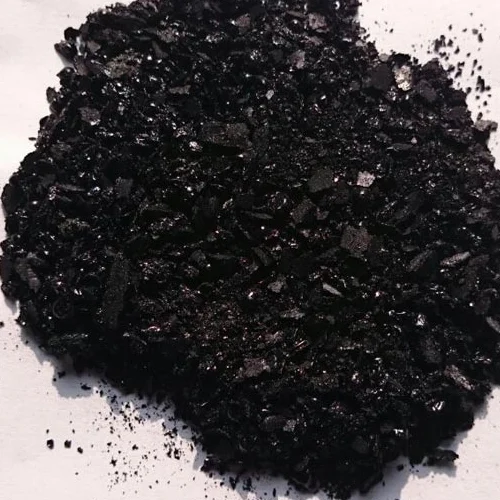best natural indigo dyes-What is Sulphur Dyes?
What is Sulphur Dyes?
Sulphur dyes are complex heterocyclic molecules or mixtures formed by melting or boiling organic compounds containing amino or nitro groups with Na-polysulphide and Sulphur. Sulphur dyes are so called as they all contain Sulphur linkage within their molecules.
The sulphur dyes are named so because of the presence of sulphur atoms in their molecules. Like direct dyes, sulphur dyes are also quite cheap for dyeing cellulosic textiles with limited colour fastness properties. Different types of sulphur dyes include:
- CI sulphur dyes
- CI leuco sulphur dyes
- CI solublized sulphur dyes
- CI condensed sulphur dyes
Sulphur dyes are highly coloured, water insoluble compounds and have to be converted in to water soluble substantive forms (lucoforms) before application to the textile materials. This conversion is carried out by a treatment with a reducing agent like dilute aqueous Na2S. Since this lucoform of Sulphur dye is substantive to cellulosic materials. They are absorbed on the fibre surface. Then they are reconverted original water insoluble form of dye by oxidation. This oxidation is carried out by “airing” (exposure to air) or by using an oxidizing agent like Na-dichromate (Na2Cr2O7).
The reducing agents converts the “S” in dye in to –SH group and the Sulphur linkages. Then inside the material the thiols containing –SH groups are oxidized & thus reconverted to original form of dye.
This is shown in the bellow:
Sulphur gives best result (Bright Tone) when they are used to produce black, Black and brown shades but red shades cannot be obtained by Sulphur dyes.
History of Sulphur Dyes
The history of Sulphur dyes may be summarized as below:
- The first Sulphur dyes where made in 1873 heating saw dust, caustic soda and Sulphur. It occurred by chance when a reaction vessel containing Na2S was leaking and the saw dust was used to wipe the solution coming out. Later a cotton fabric come in contact with this contaminated sawdust and become stained.
- The real pioneer of Sulphur dyes was vidal who produce vidal black (Name of Sulphur dye) by fusing para-phenylene diamine with Na2S & Sulphur in 1893.
- In 1897 Kalischer produced Immedial Black FF by heating 2, 4-dinitro-4-dihydroxy diphenylamine with Na-poly sulphide.
- In 1896 Read Holliday introduced a range of grey, brown and black Sulphur dyes by the action of Sulphur, alkali sulphides and many organic compounds.
-
Sulphur Black

-
Properties of Sulphur Dyes:
The main properties and characteristics features of Sulphur dyes are mentioned below:-- Sulphur dyes have Sulphur linkage within their molecules.
- Sulphur dyes are highly colouerd water insoluble dyes. Some dyes are partially soluble in water.
- They have no direct affinity towards cellulosic fibres. To make them substantive they are to be converted in to soluble lucoform by treating them with reducing agents (Like dilute Na2S solution)
- Sulphur dyes have good light fastness with rating about 4. This light fastness may be improved by an after treatment with metallic salt.
- These dyes have excellent wash fastness with rating about 3-4. This good wash fastness is due to its larger molecular size & insolubility in water.
- They are not applicable to wool due to strong alkaline condition.
- They are exclusively amorphous, few of them show crystallinity.
- Important for producing a wide range of shades on a varity of cotton and rayon.
- Sulphur dyes are suitable for heavy & durable shades
- Available in powder and soluble form
- Sulphur dyes are cheap & easy to manufacture.
- Heat and chemical resistance of Sulphur dyes are moderate to good. They have poor fastness to chlorine and are not applied to goods which are bleached with hypochlorite.
Features of Sulphur Dye
- Amorphous Colloidal materials.
- High molecular weight with various composition
- Complex molecular structure –heterocyclic molecules containing Sulphur linkage.
- Decomposed by acids, with the liberation of H2S.
- Characterized by thiozine ring, containing Sulphur atom.
-
The Timeless Art of Denim Indigo Dye
NewsJul.01,2025
-
The Rise of Sulfur Dyed Denim
NewsJul.01,2025
-
The Rich Revival of the Best Indigo Dye
NewsJul.01,2025
-
The Enduring Strength of Sulphur Black
NewsJul.01,2025
-
The Ancient Art of Chinese Indigo Dye
NewsJul.01,2025
-
Industry Power of Indigo
NewsJul.01,2025
-
Black Sulfur is Leading the Next Wave
NewsJul.01,2025

Sulphur Black
1.Name: sulphur black; Sulfur Black; Sulphur Black 1;
2.Structure formula:
3.Molecule formula: C6H4N2O5
4.CAS No.: 1326-82-5
5.HS code: 32041911
6.Product specification:Appearance:black phosphorus flakes; black liquid

Bromo Indigo; Vat Bromo-Indigo; C.I.Vat Blue 5
1.Name: Bromo indigo; Vat bromo-indigo; C.I.Vat blue 5;
2.Structure formula:
3.Molecule formula: C16H6Br4N2O2
4.CAS No.: 2475-31-2
5.HS code: 3204151000 6.Major usage and instruction: Be mainly used to dye cotton fabrics.

Indigo Blue Vat Blue
1.Name: indigo blue,vat blue 1,
2.Structure formula:
3.Molecule formula: C16H10N2O2
4.. CAS No.: 482-89-3
5.Molecule weight: 262.62
6.HS code: 3204151000
7.Major usage and instruction: Be mainly used to dye cotton fabrics.

